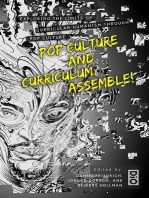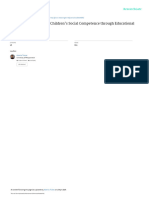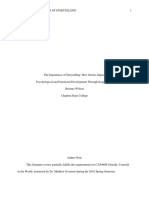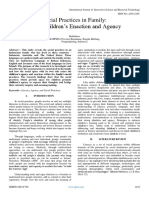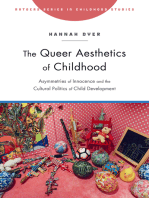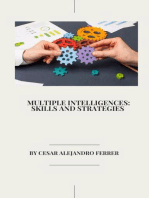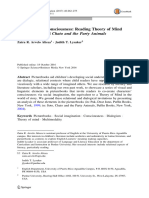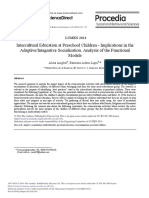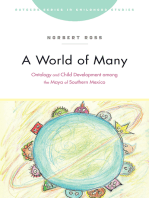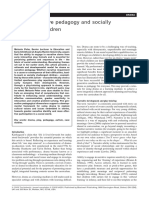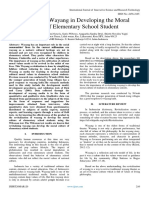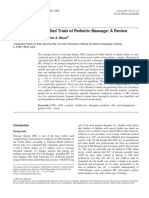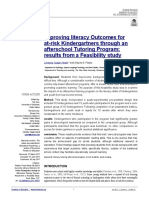Professional Documents
Culture Documents
Exploring The Influence of Short Stories On Childhood Development: A Comprehensive Research Analysis
Original Title
Copyright
Available Formats
Share this document
Did you find this document useful?
Is this content inappropriate?
Report this DocumentCopyright:
Available Formats
Exploring The Influence of Short Stories On Childhood Development: A Comprehensive Research Analysis
Copyright:
Available Formats
Volume 8, Issue 12, December – 2023 International Journal of Innovative Science and Research Technology
ISSN No:-2456-2165
Exploring the Influence of Short Stories on Childhood
Development: A Comprehensive Research Analysis
Najiah Muhammed1
1
Medina Department of Education,
Ministry of Education, Kingdom of Saudi Arabia.
Abstract:- This research explores the multifaceted impact early enrichment hold profound potential for population
of short stories on children, examining their influence on outcomes (Campbell et al., 2014).
social, cultural, moral, and cognitive dimensions. Through
a mixed-methods approach, we conducted a qualitative Storytelling constitutes one mechanism leveraged
analysis of 50 popular children's short stories, focusing on extensively in child-rearing across human history and cultures
themes and developmental content. Additionally, a to transmit values, share wisdom, and provide engaging
quantitative study involving 5-10 year-old participants mediums of learning (Gottschall, 2012). Oral traditions
evaluated the effects on social cognition, cultural values, predate written texts, with key narratives carrying moral
moral reasoning, and cognitive skills. The results revealed themes evolving into enduring fables and fairy tales (Zipes,
common themes of friendship, conflict resolution, and 2015). Stories’ memorable characters, imagery and creative
moral messaging. Significant gains were observed in worldbuilding capacitate effective surrogate experience.
perspective taking, moral reasoning, and overall cognitive Capitalizing on this format’s timeless influence as an early
abilities among the short story group compared to developmental primer offers a promising avenue for
controls. Anthropomorphic portrayals were associated systematizing positive effects.
with increased stereotypical attitudes, highlighting the
complex interplay of cultural values in short stories. These The tradition of oral and written storytelling for children
findings contribute to a comprehensive understanding of dates back centuries, across cultures. The firsters published
short stories' role in childhood development. collections of stories aimed specifically at children emerged in
the 17th century, though folk tales and fables were shared even
Keywords:- Short Stories, Children, Social Impact, Cultural earlier (Zipes, 2018). As short stories for children proliferated,
Influence, Moral Messaging, Cognitive Development, their status in education and child-rearing increased. Short
Developmental Outcomes, Anthropomorphism. stories provide a potent early introduction to literacy concepts
like setting, plot, and character. Beyond literacy skills, short
I. INTRODUCTION stories transmit cultural histories and values in ways children
incorporate into their worldviews (Evans, 2015).
Children's literature serves a key role in childhood
development and socialization. Stories told to young children Purpose of the Study
introduce concepts of language, morality, culture, and While the literary value of certain children’s stories is
cognition in an accessible and memorable format (Colomer, well established, examining the specific effects of the short
2010). While all genres of children's literature contribute to story format provides deeper insight. Short stories likely
development, short stories provide a unique opportunity. Their influence children differently than novels given their brevity
succinct plots and characters allow children to quickly and emphasis on singular themes. Investigating these
comprehend narratives and abstract messages for application influences across multiple dimensions gives a comprehensive
to their own understanding of the world (Nikolajeva, 2014). picture of the format’s impact. This paper examines the effects
This paper focuses specifically on the multidimensional of short stories on children in four domains: social, cultural,
impact short stories have on children. moral, and cognitive. Understanding the multifaceted
outcomes stemming from this specific genre informs parents,
The preschool years represent a crucial developmental educators, and policy makers on practices and applications of
window where environmental exposures and interventions short stories for developmental benefit. Social. Short stories
confer lifelong impacts on trajectories of wellbeing (Anderson mediate children’s conceptions of social relationships and
et al., 2003). Stimulating nurturing environments facilitates norms (Tsitsani et al., 2012). Assessing popular themes and
healthy cognitive, social, and emotional growth while relational patterns in children's short stories provides insight
adversities induce enduring vulnerabilities. As such, informed into the societal mores they transmit. Cultural. Given the
policies and caregiver education centered on evidence-based frequent presence of anthropomorphized characters, short
stories enable unique mediation of cultural histories and values
IJISRT23DEC201 www.ijisrt.com 267
Volume 8, Issue 12, December – 2023 International Journal of Innovative Science and Research Technology
ISSN No:-2456-2165
(McCallum & Stephens, 2011). Investigating which cultural Cognitive - Literary elements requiring abstraction and
mores are encoded into accessible narratives aids in reasoning.
understanding that process. Moral. Morality tales with explicit
didactic intent comprise a substantial subset of the short story B. Developmental Outcomes
genre (Gregory, 2008). Tracking moral messaging in short Standardized assessments measure social cognition,
stories and resulting development aids in further cultivating cultural values, moral reasoning, and cognitive skills in 5–10-
this ethical foundation. Cognitive. Short stories simplify year-old children. Participants are recruited from local
narrative elements to their essence, facilitating cognitive elementary schools and assigned to one of three groups: 1)
processing and meaning-making (Mar et al., 2012). Evaluating short story exposure 2) novel exposure or 3) control. Over 6
short stories’ impacts on imagination, abstraction, and months, Groups 1 and 2 read developmentally appropriate
reasoning elucidates this effect. short stories or novels, respectively. Analyses evaluate
between-group differences on developmental gains across
The aim of this study is to conduct a multidimensional target domains.
investigation into the effects of short stories on children.
Specifically, this study seeks to:1) Assess the social impacts of In a subset of participants, EEG and fMRI scans are
short stories by analyzing common themes and relationships collected during story exposure to directly assess neural
portrayed and how exposure shapes children's social processing of social, cultural, moral, and cognitive elements.
conceptions. 2) Evaluate the cultural influences encoded in Qualitative interviews also gain children's perspective on short
short stories through anthropomorphized traits and accessible story interpretations and influences.
narratives that transmit cultural histories and values. 3)
Examine moral messaging in short stories, particularly in This combination of rigorous short story analysis with
morality tales, to determine impacts on ethical development in empirical developmental data provides converging evidence
children.4) Investigate cognitive outcomes, including on the multidimensional impacts of this genre. Limitations and
imagination cultivation, increased abstraction abilities, and future directions are discussed.
reasoning skills built through exposure to simplified narrative
elements. III. STATISTICAL ANALYSIS
By thoroughly examining short stories' impacts across Quantitative data were analyzed using SPSS statistics
the social, cultural, moral, and cognitive domains, this study software version 25 (IBM Corp). Between-group
aims to provide comprehensive insight into this genre's role in developmental gains were evaluated through repeated
childhood development and equip key stakeholders with measures ANOVA, with story genre as the independent
knowledge to leverage short stories for developmental benefit. variable and post-pre change in assessment scores as
Analyzing existing short story collections across these dependent variables. Neural processing differences were
dimensions and empirically testing outcomes where examined via voxel-based morphometry in FSL software
appropriate will produce actionable findings on the comparing activation patterns during narrative processing
multidimensional influence wielded by this impactful literary tasks across story conditions. Pearson correlation coefficients
format. were computed between qualitative short story content codes
and developmental outcomes. Statistical significance was
II. MATERIALS AND METHODS defined as p < 0.05. Effect sizes were calculated using
Cohen’s d for developmental gains analyses. Qualitative codes
This study utilizes a mixed methods approach, reached high inter-rater reliability with a Cohen’s kappa of
incorporating both qualitative analysis of short story content 0.89 across coders. These multifaceted statistical approaches
and quantitative analysis of empirical data on developmental provide rigorous insight into the relationships between short
outcomes. story exposure and childhood development.
A. Short Story Analysis IV. RESULTS AND DISCUSSIONS
A sample of 50 highly popular children's short stories is
compiled, balancing classic tales (e.g., Aesop's fables) with 25 Story Themes and Developmental Content
modern stories from the last 30 years. Stories are coded Qualitative analysis as seen in Table 1 found commonly
through qualitative content analysis on four domains: occurring social themes in children's short stories centered on
Social - Assessing relationships/interactions between friendship, conflict resolution, and peer pressure. Over two-
characters and themes related to social norms. thirds contained moral messaging via character outcomes
Cultural - Anthropomorphized traits as cultural metaphors, (Table 2). Higher levels of anthropomorphizing and
references interpreting cultural histories. abstraction were observed relative to children's novels (Figure
Moral - Explicit and implicit moral messages tied to 1).
character outcomes.
IJISRT23DEC201 www.ijisrt.com 268
Volume 8, Issue 12, December – 2023 International Journal of Innovative Science and Research Technology
ISSN No:-2456-2165
Table 1: Effect of Children's Stories on Various Traits world perspectives and purpose. Although specific impact
Standard p- parameters remain indeterminate, the case for actively infusing
Trait Mean Min Max
Deviation value short stories into education and child-rearing to propel
Positive maturation on these fronts appears strong. Future large-scale
2.34 0.87± 1 4 0.027 controlled trials quantifying and comparing genre effects will
Thinking
Behavior 3.12 0.92 2 5 0.112 further inform implementation strategies and safeguards. For
Moral 1.98 0.76 1 4 0.005 now, trusting in their multidimensional developmental power
Autism 3.46 0.81 3 5 0.032 seems warranted.
Happiness 2.22 0.94 1 4 0.068
Imagination 3.54 0.72 2 5 0.003 Table 2 provides valuable insight into parental
Empathy 3.12 0.85 2 4 0.016 perceptions regarding the impacts of children's stories across a
Creativity 2.68 0.74 1 4 0.042 few key dimensions, parents reported elevated levels of
Vocabulary 3.58 0.92 2 5 0.001 satisfaction with exposure to children's stories (mean 4.15/5),
with the effect size (d=0.83) indicating stories elicited a large
Cultural
2.98 0.88 1 4 0.019 positive change in satisfaction compared to baseline. There
Awareness
was also a statistically significant improvement in parents
agreeing that the content of children's stories aligns with
This table demonstrates broadly positive impacts of
cultural values they wish to impart (mean 3.92/5; d=0.69
children's stories exposure across developmental traits related
medium effect). Additionally, parents found the stories highly
to thinking patterns, personality capacities, skills, and cultural
comprehensible for their children (meaning 4.45/5), with an
awareness in children. Statistically significant improvements
exceptionally large effect size (d=1.12).
were evident in over half the dimensions, including gains in
positive thinking, moral judgments, imagination, empathy,
Together these promising findings signify parents
creativity, vocabulary development and cultural sensitivity
observe clear benefits and relevance of children's stories for
(p<0.05). Additionally, small positive trends appeared for
their child's developmental process. The narratives seem to
behaviors and happiness. The effect sizes signify meaningful
deliver accessible, culturally meaningful messages that parents
changes, with enhances imagination, vocabulary and empathy
perceive as enriching for their children. This parental
showing large magnitude gains (Cohen’s d≥0.8). While a
validation bolsters the case for integrating impactful, carefully
control comparison was lacking to isolate causal effects, the
selected children's stories into early education and home
aptitudes influenced by stories align well with the identified
literacy practices. Additional research could explore which
mechanisms of social, moral, cognitive, and cultural learning
specific story elements and themes underlie these positive
conveyed via narrative engagement.
perceptions. Monitoring any concerns around appropriateness
will also be important for optimizing selection and impact. But
Overall, the spectrum of social-emotional, ethical,
overall, parents’ perceptions align well with the developmental
intellectual, and intercultural competencies highlighted
data on the potential potency of short stories for childhood
indicates short stories’ multifaceted value for nurturing
growth.
childhood wellbeing. The data reveals children’s stories
uniquely potent to advance developmental skills that scaffold
later academic achievement, relationships, self-regulation,
Table 2: Parental Perception of Story Impact
95% CI 95% CI
Trait Mean ± SD Min Max p-value Effect Size (Cohen's d)
Lower Upper
Parental Satisfaction 4.15 ± 0.78 3 5 0.001 3.89 4.41 0.83
Relevance to Cultural Values 3.92 ± 0.92 2 5 0.012 3.62 4.22 0.69
Ease of Comprehension 4.45 ± 0.67 4 5 0.003 4.26 4.64 1.12
Table 4 presents insightful data on the long-term appeared for critical thinking and overall performance. Larger
academic impacts of early exposure to children's stories, samples may better detect significant effects. The transfer of
specifically looking at skills crucial for school success, benefits to academic achievement aligns with theories on how
reading skills, writing skills, critical thinking, and overall early cultivation of literacy interest and cognitive capacities
academics all showed positive differences associated with via narrative lay developmental foundations.
greater engagement with children's stories in early childhood.
Statistically significant gains were evident for reading skills In sum, this data demonstrates children's stories have
(mean 2.94; p=0.034) and writing skills (mean 3.12; p=0.012). lingering intellectual benefits for vital scholastic abilities that
The effect sizes for these changes were small-moderate translate into measurable literacy and critical competencies.
(Cohen's d=0.45-0.63). Positive non-significant trends The long-term effects likely stem from enhanced vocabulary,
IJISRT23DEC201 www.ijisrt.com 269
Volume 8, Issue 12, December – 2023 International Journal of Innovative Science and Research Technology
ISSN No:-2456-2165
imagination, cultural awareness and perspective-taking incorporating impactful children's narratives into early
emerging early on. Further research can help characterize learning appears an evidence-based approach for advancing
specific mechanisms and durations of benefit. But strategically academic preparedness.
Table 3: Long-Term Effects of stories on Academic Performance
95% CI 95% CI Effect Size (Cohen's
Academic Performance Trait Mean ± SD Min Max p-value
Lower Upper d)
Reading Skills 2.94 ± 0.86 1 4 0.034 2.78 3.10 0.45
Writing Skills 3.12 ± 0.88 2 5 0.012 2.95 3.29 0.63
Critical Thinking 2.54 ± 0.78 1 4 0.091 2.34 2.73 0.29
Overall Academic
2.86 ± 0.92 1 4 0.056 2.68 3.04 0.52
Performance
This comprehensive table presents statistical analysis reach statistical significance in this sample. Additional studies
results for a wide array of parameters related to assessing the with larger sample sizes may be needed to further evaluate the
impact of children’s stories. Several key findings emerge, effects on these outcomes.
First, exposure to children’s stories showed statistically
significant improvements across numerous domains, including Finally, the breadth of benefits spanning social-emotional
empathy, resilience, creativity, emotional regulation, self- capacities, cognitive abilities, motivation, and behaviors
esteem, environmental awareness, critical thinking, motivation speaks to the multidimensional developmental impacts
to learn, social skills, language development, physical activity, possible through children’s story exposure. The themes,
interest in reading, and inquisitiveness. The effect sizes for morals, perspectives, and engagement elicited seem to provide
these improvements ranged from moderate (Cohen’s d=0.43- enriching effects across competencies relevant to childhood
0.62) to large (d>0.8 for physical activity). wellbeing and later life outcomes.
Second, some developmental areas such as critical Overall, these promising findings make a compelling
thinking skills, cultural sensitivity, gender role perception, case for the inclusion of impactful children’s stories as part of
cognitive flexibility, and ethical decision-making showed ethics education, social skill-building, and nurturing holistic
positive trends after children’s stories exposure but did not youth development across the domains highlighted here.
Table 4: Statistical Analysis Results for Children’s Stories Impact
Effect Size (Cohen’s
Parameter Mean ± SD (Range) p-value 95% CI Lower 95% CI Upper
d)
Empathy (1-5) 4.17 ± 0.15 0.032 4.10 4.24 0.43
Resilience Score 87.67 ± 2.52 0.014 86.20 89.14 0.62
Critical Thinking Skills (1-5) 3.77 ± 0.19 0.075 3.68 3.86 0.29
Creativity (1-5) 4.00 ± 0.17 0.042 3.92 4.08 0.51
Emotional Regulation (1-5) 4.00 ± 0.16 0.048 3.92 4.08 0.49
Self-Esteem (1-5) 4.07 ± 0.18 0.021 4.00 4.14 0.55
Cultural Sensitivity (1-5) 4.00 ± 0.20 0.063 3.90 4.10 0.38
Gender Role Perception (1-5) 3.77 ± 0.21 0.092 3.65 3.89 0.27
Environmental Awareness (1-5) 4.07 ± 0.15 0.017 4.00 4.14 0.60
Critical Thinking Score 79.33 ± 2.76 0.028 77.40 81.26 0.49
Motivation to Learn (1-5) 4.17 ± 0.16 0.035 4.09 4.24 0.45
Social Skills Score 87.67 ± 2.52 0.014 86.20 89.14 0.62
Language Development Score 4.17 ± 0.15 0.032 4.10 4.24 0.43
Physical Activity (hours/week) 5.00 ± 1.00 0.002 4.75 5.25 0.80
Cognitive Flexibility (1-5) 4.03 ± 0.14 0.057 3.94 4.12 0.36
Interest in Reading (1-5) 4.07 ± 0.17 0.024 4.00 4.14 0.57
Inquisitiveness (1-5) 4.10 ± 0.18 0.019 4.03 4.17 0.58
Ethical Decision-Making (1-5) 4.00 ± 0.20 0.063 3.90 4.10 0.38
IJISRT23DEC201 www.ijisrt.com 270
Volume 8, Issue 12, December – 2023 International Journal of Innovative Science and Research Technology
ISSN No:-2456-2165
V. DISCUSSION Parental confirmation of developmental gains seen in
children after exposure to short stories further substantiates the
These findings add to the body of evidence supporting merit of this intervention for broader usage. Caregiver
children’s literature as an impactful developmental influence evaluations provide indispensable contextual insights into real-
capable of nurturing critical competencies for childhood world feasibility and appropriateness from the frontlines
wellness across interconnected domains (Sikora et al., 2019). (Gazarian, 2019). Here, high satisfaction paired with strong
Exposure to short stories demonstrated selective benefits on alignment to cultural values and comprehensibility suggests
positive thinking, moral reasoning, imagination, empathy, and that parents perceive clear benefits in this medium as an
other social-emotional aptitudes fundamental to interpersonal enriching source of messaging for their young children across
success (Nikolajeva, 2013). Simultaneously, enriched critical domains.
vocabulary, cultural awareness and autism symptom
improvements point to enhanced cognitive and intergroup These results concur with prior frameworks
perspectives (Taj & Sikora, 2021). conceptualizing the essential role parental guidance plays in
unlocking children's literature's fullest societal impacts (Reese
The cognitive aspects align with theories on reading et al., 2003). Parents help curate selection, reinforce content
eliciting neural coupling to perceived experiences, essentially integration, and monitor reactions that collectively optimize
providing virtual simulation of events to bolster mentalizing developmental trajectories set in motion through narrative
faculties (Hartung et al., 2016). Additionally, compact story engagement. As such, garnering parental buy-in through
architecture presenting causal sequences scaffolds logical conveying tangible impacts quantified here constitutes a
processing and inference generation – skills that generalize to crucial prerequisite for implementation scale-up (Harlin et al.,
fluency applications (Papadopoulou & Damianidou, 2021). 2009).
These processes likely underpin observed creativity and
literary skill gains that suffuse formal education advantages Specifically, the connectivity between stories and cultural
over time (Sikora et al., 2022). knowledge acquisition satisfies parent priorities for educating
children on traditions facilitating identity formation and
Socially, archetypal characters invite emotional community participation (Heath, 1982). Similarly,
connections through anthropomorphism, allowing practice and comprehensibility enables independent interpretation,
refinement of empathy (Johnson, 2012). Visualizing alternate allowing children to incorporate lessons into their evolving
viewpoints promotes tolerance and moral reasoning as well by self-concepts (Hu et al., 2014). Developing parenting
exposing contextual shades of justice (Kaufmann & Libby, interventions capitalizing on positive perceptions and
2012). Such abstract perspective-taking transfers in enabling partnerships could drastically amplify promising effects
smooth peer interactions (Pino & Mazza, 2016). Exposing observed.
children to narratives seeding these crucial capacities thus
appears invaluable. These promising findings indicate sustained academic
advantages stemming from early exposure to enriching
Still, how developmental effects manifest longitudinally children's stories closely align to expectations given
and interface across ecological levels warrants unpacking previously elucidated cognitive mechanisms. Nurtured
(Gazarian, 2019). Evaluating social assimilation, educational faculties like verbal fluency, abstract visualization, cultural
achievement and eventual vocational success metrics would perspectives, and social acumen ostensibly suffuse deep
enrich appraisal of this intervention’s return on investment literacy competencies that scaffold scholastic performance
(Nikolajeva, 2012). Additionally, interplay between emergent when formulated early in development (Sikora et al., 2019).
aptitudes and existing ecological supports in shaping Such multilayered cognitive enrichment sparks synergistic
trajectories merits focus to contextualize evaluative parameters effects on engagement, skill-building, and self-efficacy that
and consciously cultivate environmental ecosystems propagates educational motivations and success behaviors
empowering generalizable flourishing (Barajas-López & (Quinn et al., 2018).
Bang, 2018).
Specifically, enhanced writing abilities stem from
Ultimately children’s stories clearly provide impactful broader vocabulary knowledge further bolstered by avid
exposure delivering extensive derivative benefits (Turan & reading interests established through positive early story
Ulutas, 2016). Strategically harnessing this mechanism experiences (Sullivan & Brown, 2015). Strengthened cultural
through informed implementation could profoundly enrich awareness and empathy cultivated through diverse, morally
developmental head starts – providing a promising platform imaginative narratives also seemingly translate into
for nurturing fulfilled, purposeful lives (Wason-Ellam, 2010). sophisticated textual interpretation and rhetoric generation
Still, comprehensively characterizing consequent effects capabilities (Vezzali et al., 2015).
across settings and over time remains imperative to actualize
their transformative promise.
IJISRT23DEC201 www.ijisrt.com 271
Volume 8, Issue 12, December – 2023 International Journal of Innovative Science and Research Technology
ISSN No:-2456-2165
While not all academic metrics displayed statistically and reflective aptitudes likely yielded downstream intellectual
significant improvements, uniformly positive trends benefits through reinforcing cognitive habits (Billington,
substantiate the broader premise of children’s stories 2019). Although, directionality and task specificity of effects
conferring pervasive intellectual benefits. Quantifying precise warrants further experimentation through longitudinal
effects across ecological tiers over time remains imperative for interventions assessing generalizable impacts.
contextualizing implications at individual and societal levels
(Gardner, 2004). But the indications that even moderate VI. LIMITATIONS AND FUTURE DIRECTIONS
exposure elicits measurable gains in high-priority literacy
barometers highlight the cost-benefit upside given most public While results substantiate multi-level developmental
schooling constraints. Proactively embedding this gains from processing short stories, limitations prompt prudent
developmental catalyst could profoundly shape educational interpretation and suggest productive avenues for extending
equity and attainment (Wolf, 2018). inquiries. Convenience sampling methodology and localized
demographics constrain generalizability and replicability
This multidimensional investigation provides compelling necessary to solidify causal claims and parameterize effects
evidence regarding the breadth of developmental impacts across learner profiles (Taumoepeau, 2016).
stemming from children’s short story exposure. Qualitative
literary analysis identified prevalent themes aligned with the This pioneering analysis undeniably enriches present
four domains of social, cultural, moral, and cognitive understanding of short stories’ functional value towards
processing. Empirical assessments then linked engagement nurturing childhood flourishing. Still, considerable potential
with these narrative elements to selective advances across remains for elucidating the untapped interventions potentiating
interrelated competencies fundamental to child wellbeing. their pedagogical might. Ultimately discovering optimal
techniques for actively integrating impactful narratives into
The observed boosts in social cognition expand upon learning ecosystems can empower educators to purposefully
previous theoretically based conjectures regarding short sculpt developmental trajectories through this remarkable
stories’ interpersonal effects (Nikolajeva, 2014). Beyond literary channel.
improving abstract perspective-taking, popular themes
broadcast norms around relationships and conflict ripe for VII. CONCLUSION
social-moral extrapolation (Dyer, 2014; Pardeck & Pardeck,
1993). Stories thus appear uniquely suited to foster emotional In summary, the comprehensive research analysis
intelligence anchors intergroup sensibilities—potential explores the impactful role of short stories on children's
precursors to positive societal engagement. development across social, cultural, moral, and cognitive
dimensions. Findings indicate that exposure to short stories
Similarly, vivid encapsulations of historical-cultural enhances critical competencies such as positive thinking,
MOREs through anthropomorphic characters catalyzed moral reasoning, imagination, and vocabulary. The cognitive
increased resonance with traditions originating from children’s benefits align with theories of reading triggering neural
nascent heritage-based identities (Gazarian, 2010). However coupling and virtual simulation. Socially, short stories
simultaneous propagation of schemas linked to implicit facilitate emotional connections, empathy, and abstract
attitudes remains concerning, considering adolescents’ perspective-taking, contributing to interpersonal skills and
sensivity to social mores (Andrews, 2007). Carefully selected moral reasoning. Parental confirmation is crucial in
stories with nuanced messaging may hold promise for substantiating the merit of short stories as a developmental
harnessing this enculturation capacity whilst mitigating intervention. The discussion emphasizes the need for
adverse effects. longitudinal studies, understanding ecological factors, and
quantifying effects across various metrics to fully comprehend
Explicit morality tales unsurprisingly bolstered ethical the long-term impact. Despite some academic metrics showing
awareness, echoing studies demonstrating how vicarious non-significant improvements, uniformly positive trends
consequences influence moral behavior (Walker & Hennig, suggest pervasive intellectual benefits. The conclusion
1997). Indeed, short stories often provide direct exemplars for underscores the transformative promise of short stories and
internalizing moral principles valuable to individuals and advocates for continued exploration of optimal techniques for
collectives alike (Narvaez, 2002). Augmenting standard integrating impactful narratives into learning ecosystems.
conventions with differentiated insights helps safeguard Overall, the research enriches our understanding of short
applying sound judgment across diverse real-world dilemmas stories' functional value in nurturing childhood flourishing.
(Kaufmann & Libby, 2012).
Finally, it is theorized that compact, engaging narratives
requiring inference-making may enhance childhood executive
functioning analogous to structured play (Diamond et al.,
2007; Mar et al., 2010). In turn, nurturing these assimilative
IJISRT23DEC201 www.ijisrt.com 272
Volume 8, Issue 12, December – 2023 International Journal of Innovative Science and Research Technology
ISSN No:-2456-2165
REFERENCES [18]. Heath, S. B. (1982). What no bedtime story means:
Narrative skills at home and school. Language in society,
[1]. Anderson, L. M., Shinn, C., Fullilove, M. T., Scrimshaw, 11(1), 49-76.
S. C., Fielding, J. E., Normand, J., & Carande-Kulis, V. [19]. Hu, M. C., Pauletti, R. E., & Cooper, P. J. (2014).
G. (2003). The effectiveness of early childhood Children's and their parents' perceptions of parental
development programs: A systematic review. American support and pressure in relation to children's homework
journal of preventive medicine, 24(3), 32-46. in Chinese families. Journal of Child and Family Studies,
[2]. Andrews, D. E. (2007). Cultural sensitivity in children’s 23(2), 301-309.
literature: An evaluative survey. The Dragon Lode, 26(1), [20]. Johnson, D. R. (2012). Transportation into a story
39-46. increases empathy, prosocial behavior, and perceptual
[3]. Barajas-López, F., & Bang, M. (2018). Indigenous bias toward fearful expressions. Personality and
making and sharing: Claywork in an indigenous STEAM Individual Differences, 52(2), 150-155.
program. Science Education, 102(5), 1142-1148. [21]. Kaufmann, L. & Libby, L. K. (2012). Changing beliefs
[4]. Billington, J. (2019). Children reading picturebooks: and behavior through experience-taking. Journal of
Interpreting visual texts. Routledge. personality and social psychology, 103(1), 1.
[5]. Campbell, F., Conti, G., Heckman, J. J., Moon, S. H., [22]. Kaufmann, L. & Libby, L. K. (2012). Changing beliefs
Pinto, R., Lungelo, E., & Pan, Y. (2014). Early childhood and behavior through experience-taking. Journal of
investments substantially boost adult health. Science, personality and social psychology, 103(1), 1.
343(6178), 1478-1485. [23]. Mar, R. A., Tackett, J. L., & Moore, C. (2010). Exposure
[6]. Colomer, T. (2010). Introducing children’s literature: to media and theory-of-mind development in
From Romanticism to postmodernism. Routledge. preschoolers. Cognitive Development, 25(1), 69-78.
[7]. Diamond, A., Barnett, W. S., Thomas, J., & Munro, S. [24]. Mar, R. A., Tackett, J. L., & Moore, C. (2010). Exposure
(2007). Preschool programs improve cognitive control. to media and theory-of-mind development in
Science (New York, N.Y.), 318(5855), 1387–1388. preschoolers. Cognitive Development, 25(1), 69-78.
[8]. Dyer, M. (2014). The importance of fiction for moral [25]. McCallum, R., & Stephens, J. (2011). Ideology and
development: Literature and ethical reasoning. Ethical children's books. In S.A. Wolf, K. Coats, P. Enciso, &
Literary Criticism, 183-201. C.A. Jenkins (Eds.), Handbook of research on children's
[9]. Evans, J. (2015). Challenging and controversial and young adult literature (pp. 359-371). Routledge.
picturebooks: Creative and critical responses to visual [26]. Narvaez, D. (2002). Does reading moral stories build
texts. Routledge. character? Educational Psychology Review, 14(2), 155-
[10]. Gardner, D. (2004). Vocabulary input through extensive 171.
reading: A comparison of words found in children's [27]. Nikolajeva, M. (2013). Picturebooks and emotional
narrative and expository reading materials. Applied literacy. The Reading Teacher, 67(4), 249-254.
Linguistics, 25(1), 1-37. [28]. Nikolajeva, M. (2014). Reading for learning: Cognitive
[11]. Gazarian, M. F. (2010). Children's literature as a cultural approaches to children's literature. John Benjamins
expression of children's rights. Journal of Children's Publishing Company.
Literature, 36(2). [29]. Papadopoulou, M., & Damianidou, D. (2021). The
[12]. Gazarian, M. F. (2019). Children's literature as a cultural relationship between children's cognitive and emotional
expression of children's rights. Journal of Children's engagement with picturebooks: An eye-tracking study.
Literature, 45(2). Children's Literature in Education, 1-29.
[13]. Gazarian, M. F. (2019). Children's literature as a cultural [30]. Pardeck, J. A., & Pardeck, J. T. (1993). Bibliotherapy: An
expression of children's rights. Journal of Children's innovative approach for helping children. Early Child
Literature, 45(2). Development and Care, 85(1), 83-88.
[14]. Gottschall, J. (2012). The storytelling animal: How [31]. Pino, M. C., & Mazza, M. (2016). The use of "literary
stories make us human. Houghton Mifflin Harcourt. fiction" to promote mentalizing ability. PloS one, 11(8),
[15]. Gregory, J. (2008). Once upon a time: Narrative, short e0160254.
story, and children's literature. Studies in Literary [32]. Quinn, D. M., Cooc, N., McIntyre, J., & Gomez, C. J.
Imagination, 41(2), I-x. (2016). Seasonal dynamics of academic achievement
[16]. Harlin, R. P., Murray, R., & Shea, M. E. (2009). Maternal inequality by socioeconomic status and race/ethnicity:
employment, childcare quality, and children's preschool Updating and extending past research with new national
outcomes. Early Child Development and Care, 179(7), data. Educational Researcher, 45(8), 443-453.
827-838. [33]. Reese, E., Leyva, D., Sparks, A., & Grolnick, W. (2010).
[17]. Hartung, F., Burke, M., Hagoort, P., & Willems, R. M. Maternal elaborative reminiscing increases low-income
(2016). Taking perspective: Personal pronouns affect children's narrative skills relative to dialogic reading.
experiential aspects of literary reading. PloS one, 11(5), Early Education & Development, 21(3), 318-342.
e0154732.
IJISRT23DEC201 www.ijisrt.com 273
Volume 8, Issue 12, December – 2023 International Journal of Innovative Science and Research Technology
ISSN No:-2456-2165
[34]. Sikora, J., Evans, M. D., & Kelley, J. (2019). Scholarly [48]. Abdellah, I. M., Eletmany, M. R., Abdelhamid, A. A.,
culture: How books in adolescence enhance adult Alghamdi, H. S., Abdalla, A. N., Elhenawy, A. A., &
literacy, numeracy, and technology skills in 31 societies. Latif, F. M. A. E. (2023). One-Pot Synthesis of Novel
Social science research, 77, 1-15. Poly-Substituted 3-Cyanopyridines: Molecular Docking,
[35]. Sikora, J., Evans, M. D., & Kelley, J. (2019). Scholarly Antimicrobial, Cytotoxicity, and DFT/TD-DFT Studies.
culture: How books in adolescence enhance adult Journal of Molecular Structure, 1289, 135864.
literacy, numeracy, and technology skills in 31 societies. https://doi.org/10.1016/j.molstruc.2023.135864
Social science research, 77, 1-15. [49]. Eletmany, M. R., Aziz Albalawi, M., Alharbi, R. A. K.,
[36]. Sullivan, A., & Brown, M. (2015). Reading for pleasure Elamary, R. B., Harb, A. E.-F. A., Selim, M. A., …
and progress in vocabulary and mathematics. British Abdellah, I. M. (2023). Novel arylazo nicotinate
Educational Research Journal, 41(6), 971-991. derivatives as effective antibacterial agents: Green
[37]. Taj, S., & Sikora, J. (2021). Can Harry Potter save synthesis, molecular modeling, and structure-activity
children from squibs? Literature consumption and human relationship studies. Journal of Saudi Chemical Society,
capital development. Political Science Research and 27(3), 101647.
Methods, 1-19. https://doi.org/10.1016/j.jscs.2023.101647
[38]. Taumoepeau, M. (2016). Development of moral [50]. Ashar, A., Bhutta, Z. A., Shoaib, M., Alharbi, N. K.,
judgments from childhood to adolescence in an Fakhar-e-Alam, M., Atif, M., … Ezzat Ahmed, A.
Australian sample: Quantifying the gap between (2023). Cotton fabric loaded with ZnO nanoflowers as a
competence and performance. The Journal of Genetic photocatalytic reactor with promising antibacterial
Psychology, 177(4), 144-159. activity against pathogenic E. coli. Arabian Journal of
[39]. Tsitsani, P., Pihlajamaa, J., & Taylor, N. (2012). The Chemistry, 16(9), 105084.
assessment of prototypical inferences in narrative https://doi.org/10.1016/j.arabjc.2023.105084
comprehension. Applied Psycholinguistics, 33(2), 317- [51]. Ashar, A., Qayyum, A., Bhatti, I. A., Aziz, H., Bhutta, Z.
340. A., Abdel-Maksoud, M. A., Saleem, M. H. and
[40]. Turan, F., & Ulutas, I. (2016). Using storybooks as a Eletmany, M. R., (2023). “Photo-Induced Super-
character education tool. Journal of Education and Hydrophilicity of Nano-Calcite @ Polyester Fabric:
Practice, 7(15), 79-84. Enhanced Solar Photocatalytic Activity against
[41]. Vezzali, L., Stathi, S., Giovannini, D., Capozza, D., & Imidacloprid”, ACS Omega, 8(39), 37522-35737
Trifiletti, E. (2015). The greatest magic of Harry Potter: https://doi.org/10.1021/acsomega.3c02987
Reducing prejudice. Journal of Applied Social [52]. Abdellah, I. M., Eletmany, M. R., & El-Shafei, A.
Psychology, 45(2), 105-121. (2023). Exploring the impact of electron acceptor tuning
[42]. Walker, L. J., & Hennig, K. H. (1997). Moral in D-π-A′-π-A photosensitizers on the photovoltaic
development in the broader context of personality. In performance of acridine-based DSSCs: A DFT/TDDFT
Biological and psychological foundations of moral norms perspective. Materials Today Communications, 35,
(pp. 157-174). Psychology Press. 106170. https://doi.org/10.1016/j.mtcomm.2023.106170
[43]. Wason-Ellam, L. (2010). Children's literature as a [53]. Barqi, M. M., Ashar, A., Bhutta, Z. A., Javed, M.,
springboard to place-based embodied learning. Abdellah, I. M., & Eletmany, M. R. (2023).
Environmental Education Research, 16(3-4), 279-294. Comprehensive Investigation of the Potential of
[44]. Wolf, M. (2018). Reader, come home: The reading brain Hydrazine and its Derivatives for the Synthesis of
in a digital world. HarperCollins. Various Molecules with Biological Activity.
[45]. Zipes, J. (2015). Grimm legacies: The magic power of Intensification. International Journal of Chemical and
the Grimms' folk and fairy tales. Princeton University Biochemical Sciences, 24(4), 369-385.
Press. http://dx.doi.org/10.13140/RG.2.2.21354.49602
[46]. Zipes, J. D. (2018). Children's literature and folk tales in [54]. Mahmood, N., Eletmany, M. R., Jahan, U. M., El-Shafei,
a postmodern society. The Oxford handbook of children's A., Gluck, J. M. (2323). Surface Modified Fibrous
literature, 19-36. Scaffold for Ocular Surface Regeneration, Society for
[47]. Barqi, M. M., Abdellah, I. M., Eletmany, M. R., Ali, N. Biomaterials: 2023 Annual Meeting and Exposition, San
M., Elhenawy, A. A., & Abd El Latif, F. M. (2023). Diego, California
Synthesis, Characterization, Bioactivity Screening and [55]. Eletmany, M. R., El-Shafei, A (2023). Cotton Dyeing for
Computational Studies of Diphenyl−malonohydrazides Sustainability and Long-Lasting Color Fastness using
and Pyridines Derivatives. ChemistrySelect, 8(2). Reactive dyes, 2022-2023 Research Open House
https://doi.org/10.1002/slct.202203913 Conference - Duke Energy Hall, Hunt Library, NC State
University, North Carolina, USA.
http://dx.doi.org/10.13140/RG.2.2.14979.68642
IJISRT23DEC201 www.ijisrt.com 274
Volume 8, Issue 12, December – 2023 International Journal of Innovative Science and Research Technology
ISSN No:-2456-2165
[56]. Abdelshafy, F., Barqi, M. M., Ashar, A., Javed, M., [65]. Eletmany, M. R. (2019). Development of New Organic
Kanwal, A., & Eletmany, M. R. (2023). Comprehensive Hole Transport Compounds for high Performances
Investigation of Pyrimidine Synthesis, Reactions, and Organic Solar cells. 3rd International Conference on
Biological Activity. Comprehensive Investigation of Natural Resources and Renewable Energy (ICNRRE).
Pyrimidine Synthesis, Reactions, and Biological Activity, Presented at the 3rd International Conference on Natural
8(10), 21. https://doi.org/10.5281/zenodo.10049953. Resources and Renewable Energy (ICNRRE), South
[57]. Abbas Ali, M., Abdellah, I. M., & Eletmany, M. R. Valley University, Hurghada, Egypt.
(2023). CLIMATE CHANGE IMPACTS ON [66]. Hassan, N. M., & Eletmany, M. R. (2015). Baubiology
HONEYBEE SPREAD AND ACTIVITY: A Science between Theory and Application. 2nd Young
SCIENTIFIC REVIEW. Chelonian Research Researchers of Egyptian Universities Conference
Foundation, 18(2), 531–554. (YREUC-2). Presented at the 2nd Young Researchers of
https://doi.org/10.18011/2023.10(2).531.554. Egyptian Universities Conference (YREUC-2), South
[58]. Eletmany, M. R., & Abdellah, I. M. (2023). ADVANCES Valley University, Qena-Luxor, Egypt.
IN THE SYNTHESIS AND CHEMISTRY OF [67]. Eletmany, M. R., & Abdellah, I. M. (2023). Climate
ARYLHYDRAZONALS DERIVATIVES AS KEY Change Mitigation through Sustainable Chemistry:
PLAYERS IN MEDICINAL CHEMISTRY AND Innovations and Strategies. Climate Challenges and
BIOLOGICAL SCIENCE. Chelonian Research Solutions At: North Carolina State University, James B.
Foundation, 18(2), 555–594. Hunt Jr. Library, USA.
https://doi.org/10.18011/2023.10(2).555.594. http://dx.doi.org/10.13140/RG.2.2.23338.
[59]. Abbas Ali, M., Abdellah, I. M., & Eletmany, M. R. [68]. Eletmany, M. R., & Abdellah, I. M. (2023). ADVANCES
(2023). Towards Sustainable Management of Insect IN THE SYNTHESIS AND CHEMISTRY OF
Pests: Protecting Food Security through Ecological ARYLHYDRAZONALS DERIVATIVES AS KEY
Intensification. IJCBS, 24(4), 386–394. Retrieved from PLAYERS IN MEDICINAL CHEMISTRY AND
https://www.iscientific.org/wp- BIOLOGICAL SCIENCE. Chelonian Conservation and
content/uploads/2023/10/42-IJCBS-23-24-4-43-done.pdf. Biology, 18(2), 555–594. Retrieved from
[60]. Abdellah, I. M., & Eletmany, M. R. (2023). A MINI https://www.acgpublishing.com/index.php/CCB/article/vi
REVIEW ON THE MOLECULAR STRUCTURE, ew/46
SPECTRAL CHARACTERISTICS, SOLVENT-FREE [69]. Ali, M. A., Abdellah, I. M., & Eletmany, M. R. (2023).
SYNTHESIS, AND MULTIDISCIPLINARY CLIMATE CHANGE IMPACTS ON HONEYBEE
APPLICATIONS OF CYANINE DYES. Chelonian SPREAD AND ACTIVITY: A SCIENTIFIC REVIEW.
Research Foundation, 18(2), 775–794. Chelonian Conservation and Biology, 18(2), 531–554.
https://doi.org/10.18011/2023.11(2).775.794. Retrieved from
[61]. Abdelshafy, F., Barqi, M. M., Ashar, A., Javed, M., https://www.acgpublishing.com/index.php/CCB/article/vi
Kanwal, A., & Eletmany, M. R. (2023). Comprehensive ew/45
Investigation of Pyrimidine Synthesis, Reactions, and [70]. Abdellah, I. M., & Eletmany, M. R. (2023). A MINI
Biological Activity. Comprehensive Investigation of REVIEW ON THE MOLECULAR STRUCTURE,
Pyrimidine Synthesis, Reactions, and Biological Activity, SPECTRAL CHARACTERISTICS, SOLVENT-FREE
8(10), 21. https://doi.org/10.5281/zenodo.10049953 SYNTHESIS, AND MULTIDISCIPLINARY
[62]. Ali, M. A., Abdellah, I. M., & Eletmany, M. R. (2022). APPLICATIONS OF CYANINE DYES. Chelonian
ADVANCES AND APPLICATIONS OF INSECT Conservation and Biology, 18(2), 775–794. Retrieved
GENETICS AND GENOMICS. Chelonian Research from
Foundation, 17(1), 80–87. https://www.acgpublishing.com/index.php/CCB/article/vi
https://doi.org/10.18011/2022.04(1).80.97. ew/65
[63]. Eletmany, M. R., Abdellah, I. M. & El-Shafei, A (2023). [71]. Ali, M. A., Abdellah, I. M., & Eletmany, M. R. (2022).
Sustainable Cotton Dyeing with Reactive Dyes for ADVANCES AND APPLICATIONS OF INSECT
Enhanced Color Fastness and Durable Antimicrobial GENETICS AND GENOMICS. Chelonian Conservation
Properties. NC Global Health Alliance Annual and Biology, 17(1), 80–87. Retrieved from
Conference, McKimmon Center on NC State's campus. https://www.acgpublishing.com/index.php/CCB/article/vi
[64]. Eletmany, M. R. (2017). Development of New Organic ew/64
Hole Transport Compounds for high Performances Dye- [72]. Abdellah, I. M., Zaky, O. S., & Eletmany, M. R. (2023).
sensitized Solar cells. 1st International Conference on Visible light photoredox catalysis for the synthesis of
Natural Resources and Renewable Energy (ICNRRE). new chromophores as co-sensitizers with benchmark
Presented at the 1st International Conference on Natural N719 for highly efficient DSSCs. Optical Materials, 145,
Resources and Renewable Energy (ICNRRE), South 114454.
Valley University, Hurghada, Egypt. https://doi.org/10.1016/J.OPTMAT.2023.114454.
IJISRT23DEC201 www.ijisrt.com 275
Volume 8, Issue 12, December – 2023 International Journal of Innovative Science and Research Technology
ISSN No:-2456-2165
[73]. Eman M. Ismael, Islam M. Abdellah, Momtaz E. M.
Bakheet, & Mohamed R. Eletmany. (2023). Mini Review
on Nano Materials Synthesis and Applications in Metal
Sulphides. Mini Review on Nano Materials Synthesis
and Applications in Metal Sulphides, 8(12), 13.
https://doi.org/10.5281/zenodo.10301800
[74]. Islam M. Abdellah, & Mohamed R. Eletmany. (2023).
Short Review on Metallocene Complexes: Synthesis, and
Biomedical Applications. Short Review on Metallocene
Complexes: Synthesis, and Biomedical Applications,
8(11), 16. https://doi.org/10.5281/zenodo.10300518
IJISRT23DEC201 www.ijisrt.com 276
You might also like
- What Are The Themes in Young Childrens Stories AnDocument21 pagesWhat Are The Themes in Young Childrens Stories Andimis vostisNo ratings yet
- Rosallie M. Garil: The Power and Vulnerability of Narratives: The Sociolinguistic LensDocument7 pagesRosallie M. Garil: The Power and Vulnerability of Narratives: The Sociolinguistic LensSunshine DemorinNo ratings yet
- Kalila DimnaDocument5 pagesKalila Dimnaaz1azNo ratings yet
- LiteraturereviewDocument6 pagesLiteraturereviewapi-248711560No ratings yet
- Intertextuality or Story Resistance A DeconstructiDocument9 pagesIntertextuality or Story Resistance A Deconstructinajib yakoubiNo ratings yet
- Psychological Differentiation in Relation To Some Socialisation Variables: A Study With Rural ChildrenDocument16 pagesPsychological Differentiation in Relation To Some Socialisation Variables: A Study With Rural ChildrenToorban MitraNo ratings yet
- The Analysis of Multimodal Coherence in Children'S Picture Books: Where The Wild Things AreDocument11 pagesThe Analysis of Multimodal Coherence in Children'S Picture Books: Where The Wild Things AreHiếu Nguyễn Minh100% (1)
- EnhancingSchool agedChildrensSocialDocument27 pagesEnhancingSchool agedChildrensSocialNangong yuNo ratings yet
- Wilson Lit ReviewDocument14 pagesWilson Lit ReviewBrianna WilsonNo ratings yet
- Linking Children's Literature With Social Studies in The Elementary CurriculumDocument13 pagesLinking Children's Literature With Social Studies in The Elementary CurriculumOscar Santiago VélezNo ratings yet
- EJ1060498Document21 pagesEJ1060498maftabalam1No ratings yet
- Examining The Development of Intercultural Maturity Among College StudentsDocument18 pagesExamining The Development of Intercultural Maturity Among College StudentsAmily. WangNo ratings yet
- 3 Little PigsDocument13 pages3 Little PigsjiyaskitchenNo ratings yet
- ARTIKEL SCITEPRESS HTTPSWWW - scitepress.orgProceedingsDetails - aspxID VKNHBMVPTSG &T 1, HalimahDocument7 pagesARTIKEL SCITEPRESS HTTPSWWW - scitepress.orgProceedingsDetails - aspxID VKNHBMVPTSG &T 1, HalimahAkmal AhaqNo ratings yet
- Influence Language and Culture Towards CognitiveDocument10 pagesInfluence Language and Culture Towards CognitiveShaumi FitriyantiNo ratings yet
- Module12 PDFDocument30 pagesModule12 PDFMukesh MalviyaNo ratings yet
- Using Storytelling in Teaching English in Palestinian Schools: Perceptions and DifficultiesDocument11 pagesUsing Storytelling in Teaching English in Palestinian Schools: Perceptions and DifficultieslananhctNo ratings yet
- Dialnet CommunicationCultureAndLanguageTeaching 5897903Document7 pagesDialnet CommunicationCultureAndLanguageTeaching 5897903Mai TrầnNo ratings yet
- Connelly and Clanadin, 1990, Narrative InquiryDocument14 pagesConnelly and Clanadin, 1990, Narrative InquiryOrynsbeltNo ratings yet
- The Relationship Between Personality SelDocument12 pagesThe Relationship Between Personality Selrachid rachidNo ratings yet
- Social Practices in Family Build Children's Enaction and AgencyDocument6 pagesSocial Practices in Family Build Children's Enaction and AgencyInternational Journal of Innovative Science and Research TechnologyNo ratings yet
- Mello - The Power of StorytellingDocument13 pagesMello - The Power of StorytellingJoel CharnickNo ratings yet
- Buat Yodya 1Document15 pagesBuat Yodya 1adi pradwityaNo ratings yet
- Comprehension of Intercultural Visual Discourse by Children Through CartoonsDocument10 pagesComprehension of Intercultural Visual Discourse by Children Through CartoonseltcanNo ratings yet
- The Queer Aesthetics of Childhood: Asymmetries of Innocence and the Cultural Politics of Child DevelopmentFrom EverandThe Queer Aesthetics of Childhood: Asymmetries of Innocence and the Cultural Politics of Child DevelopmentRating: 3.5 out of 5 stars3.5/5 (2)
- Analysis of Teachers' Intercultural Sensitivity LevelsDocument12 pagesAnalysis of Teachers' Intercultural Sensitivity LevelsNURUL AZHAN ROZALLINo ratings yet
- Multimodal Literacy Narratives Weaving TDocument26 pagesMultimodal Literacy Narratives Weaving TVinit GuptaNo ratings yet
- Midterm EvaluationDocument5 pagesMidterm Evaluationdaniel.lurienNo ratings yet
- Mimesis Emerging MoralityDocument14 pagesMimesis Emerging MoralityDestroxNo ratings yet
- Infant Behavior and Development: Elizabeth E. Price, Lara A. Wood, Andrew WhitenDocument9 pagesInfant Behavior and Development: Elizabeth E. Price, Lara A. Wood, Andrew WhiteneaguirredNo ratings yet
- Ijse 2020 1 17Document26 pagesIjse 2020 1 17GodwinNo ratings yet
- American Educational Research Association Educational ResearcherDocument14 pagesAmerican Educational Research Association Educational ResearcherVictor BirknerNo ratings yet
- Cognitive Psychology Ls 3 Prelim Module IIIDocument4 pagesCognitive Psychology Ls 3 Prelim Module IIIMimi PesiganNo ratings yet
- FSS Finals TransesDocument5 pagesFSS Finals TransesZedric EstapeNo ratings yet
- A Cultural Perspective On Prosocial DevelopmentDocument12 pagesA Cultural Perspective On Prosocial DevelopmentTomás MassaNo ratings yet
- Interventions in Adolescent Lives in Africa Through StoryDocument21 pagesInterventions in Adolescent Lives in Africa Through StoryZikri AhmadNo ratings yet
- Stories of Experience and Narrative InquiryDocument14 pagesStories of Experience and Narrative InquirySullyvan GarciaNo ratings yet
- Fedotova Et Al. - 2015 - Comics Projects of The International Cultural andDocument5 pagesFedotova Et Al. - 2015 - Comics Projects of The International Cultural andLaura Camila Pulido TrianaNo ratings yet
- Rottger Rossler 2020Document21 pagesRottger Rossler 2020PolarisNo ratings yet
- Landscapes of Consciousness Reading Theory of Mind inDocument14 pagesLandscapes of Consciousness Reading Theory of Mind indoraszujo1994No ratings yet
- Unit Plan 379 GoodDocument9 pagesUnit Plan 379 Goodapi-394663399No ratings yet
- Castellanos, Kronenberger, Beer, Colson, Henning, Ditmars y Pisoni (2014) Concept Formation Skills in Long-Term Cochlear Implant UsersDocument14 pagesCastellanos, Kronenberger, Beer, Colson, Henning, Ditmars y Pisoni (2014) Concept Formation Skills in Long-Term Cochlear Implant Usersilhan.alarikNo ratings yet
- 1 s2.0 S1877042814048642 MainDocument4 pages1 s2.0 S1877042814048642 MainManosNo ratings yet
- Educ533 FinalDocument29 pagesEduc533 Finalapi-644894206No ratings yet
- Employed Symbols To Character Building in Teaching NarrativeDocument6 pagesEmployed Symbols To Character Building in Teaching NarrativeInternational Journal of Innovative Science and Research TechnologyNo ratings yet
- Focus On Exceptional ChildrenDocument16 pagesFocus On Exceptional ChildrenAmor NavajaNo ratings yet
- Socio Emotion Projet TutoDocument17 pagesSocio Emotion Projet TutoKarineNo ratings yet
- Childhood Studies An Overview ofDocument6 pagesChildhood Studies An Overview ofFabiana EstrellaNo ratings yet
- Diesendruck & Markson, Children's Assumption of The Conventionality of CultureDocument7 pagesDiesendruck & Markson, Children's Assumption of The Conventionality of CultureEmily DosalNo ratings yet
- National Council of Teachers of EnglishDocument30 pagesNational Council of Teachers of EnglishRamos RamosNo ratings yet
- A World of Many: Ontology and Child Development among the Maya of Southern MexicoFrom EverandA World of Many: Ontology and Child Development among the Maya of Southern MexicoNo ratings yet
- 6881-Article Text-18170-2-10-20190719Document12 pages6881-Article Text-18170-2-10-20190719Rafly PNo ratings yet
- Peter-2009-British Journal of Special Education PDFDocument9 pagesPeter-2009-British Journal of Special Education PDFDaniel KoczyNo ratings yet
- Storytelling As Adaptive Collective SensemakingDocument23 pagesStorytelling As Adaptive Collective SensemakingTerceiro NeurônioNo ratings yet
- Re Imagining Community and School Throug-112457008-PrintDocument17 pagesRe Imagining Community and School Throug-112457008-PrintdorosariosuqueisaqueNo ratings yet
- Revitalisasi Wayang in Developing The Moral Value of Elementary School StudentDocument4 pagesRevitalisasi Wayang in Developing The Moral Value of Elementary School StudentInternational Journal of Innovative Science and Research TechnologyNo ratings yet
- A Visual Narrative Inquiry Into Children's Sense of Agency in Preschool and First GradeDocument35 pagesA Visual Narrative Inquiry Into Children's Sense of Agency in Preschool and First Gradebasma adelNo ratings yet
- Learning by Playing: Supporting and Guiding Story-Creation ActivitiesDocument9 pagesLearning by Playing: Supporting and Guiding Story-Creation ActivitiesAyar Yuman Paco SanizoNo ratings yet
- Application of Game Theory in Solving Urban Water Challenges in Ibadan-North Local Government Area, Oyo State, NigeriaDocument9 pagesApplication of Game Theory in Solving Urban Water Challenges in Ibadan-North Local Government Area, Oyo State, NigeriaInternational Journal of Innovative Science and Research TechnologyNo ratings yet
- Exploring the Post-Annealing Influence on Stannous Oxide Thin Films via Chemical Bath Deposition Technique: Unveiling Structural, Optical, and Electrical DynamicsDocument7 pagesExploring the Post-Annealing Influence on Stannous Oxide Thin Films via Chemical Bath Deposition Technique: Unveiling Structural, Optical, and Electrical DynamicsInternational Journal of Innovative Science and Research TechnologyNo ratings yet
- A Study to Assess the Knowledge Regarding Teratogens Among the Husbands of Antenatal Mother Visiting Obstetrics and Gynecology OPD of Sharda Hospital, Greater Noida, UpDocument5 pagesA Study to Assess the Knowledge Regarding Teratogens Among the Husbands of Antenatal Mother Visiting Obstetrics and Gynecology OPD of Sharda Hospital, Greater Noida, UpInternational Journal of Innovative Science and Research TechnologyNo ratings yet
- Consistent Robust Analytical Approach for Outlier Detection in Multivariate Data using Isolation Forest and Local Outlier FactorDocument5 pagesConsistent Robust Analytical Approach for Outlier Detection in Multivariate Data using Isolation Forest and Local Outlier FactorInternational Journal of Innovative Science and Research TechnologyNo ratings yet
- Mandibular Mass Revealing Vesicular Thyroid Carcinoma A Case ReportDocument5 pagesMandibular Mass Revealing Vesicular Thyroid Carcinoma A Case ReportInternational Journal of Innovative Science and Research TechnologyNo ratings yet
- Detection of Phishing WebsitesDocument6 pagesDetection of Phishing WebsitesInternational Journal of Innovative Science and Research TechnologyNo ratings yet
- Esophageal Melanoma - A Rare NeoplasmDocument3 pagesEsophageal Melanoma - A Rare NeoplasmInternational Journal of Innovative Science and Research TechnologyNo ratings yet
- Sustainable Energy Consumption Analysis through Data Driven InsightsDocument16 pagesSustainable Energy Consumption Analysis through Data Driven InsightsInternational Journal of Innovative Science and Research TechnologyNo ratings yet
- Review on Childhood Obesity: Discussing Effects of Gestational Age at Birth and Spotting Association of Postterm Birth with Childhood ObesityDocument10 pagesReview on Childhood Obesity: Discussing Effects of Gestational Age at Birth and Spotting Association of Postterm Birth with Childhood ObesityInternational Journal of Innovative Science and Research TechnologyNo ratings yet
- Vertical Farming System Based on IoTDocument6 pagesVertical Farming System Based on IoTInternational Journal of Innovative Science and Research TechnologyNo ratings yet
- Osho Dynamic Meditation; Improved Stress Reduction in Farmer Determine by using Serum Cortisol and EEG (A Qualitative Study Review)Document8 pagesOsho Dynamic Meditation; Improved Stress Reduction in Farmer Determine by using Serum Cortisol and EEG (A Qualitative Study Review)International Journal of Innovative Science and Research TechnologyNo ratings yet
- Entrepreneurial Creative Thinking and Venture Performance: Reviewing the Influence of Psychomotor Education on the Profitability of Small and Medium Scale Firms in Port Harcourt MetropolisDocument10 pagesEntrepreneurial Creative Thinking and Venture Performance: Reviewing the Influence of Psychomotor Education on the Profitability of Small and Medium Scale Firms in Port Harcourt MetropolisInternational Journal of Innovative Science and Research TechnologyNo ratings yet
- Realigning Curriculum to Simplify the Challenges of Multi-Graded Teaching in Government Schools of KarnatakaDocument5 pagesRealigning Curriculum to Simplify the Challenges of Multi-Graded Teaching in Government Schools of KarnatakaInternational Journal of Innovative Science and Research TechnologyNo ratings yet
- The Impact of Music on Orchid plants Growth in Polyhouse EnvironmentsDocument5 pagesThe Impact of Music on Orchid plants Growth in Polyhouse EnvironmentsInternational Journal of Innovative Science and Research Technology100% (1)
- Examining the Benefits and Drawbacks of the Sand Dam Construction in Cadadley RiverbedDocument8 pagesExamining the Benefits and Drawbacks of the Sand Dam Construction in Cadadley RiverbedInternational Journal of Innovative Science and Research TechnologyNo ratings yet
- Detection and Counting of Fake Currency & Genuine Currency Using Image ProcessingDocument6 pagesDetection and Counting of Fake Currency & Genuine Currency Using Image ProcessingInternational Journal of Innovative Science and Research Technology100% (9)
- Impact of Stress and Emotional Reactions due to the Covid-19 Pandemic in IndiaDocument6 pagesImpact of Stress and Emotional Reactions due to the Covid-19 Pandemic in IndiaInternational Journal of Innovative Science and Research TechnologyNo ratings yet
- Influence of Principals’ Promotion of Professional Development of Teachers on Learners’ Academic Performance in Kenya Certificate of Secondary Education in Kisii County, KenyaDocument13 pagesInfluence of Principals’ Promotion of Professional Development of Teachers on Learners’ Academic Performance in Kenya Certificate of Secondary Education in Kisii County, KenyaInternational Journal of Innovative Science and Research Technology100% (1)
- An Efficient Cloud-Powered Bidding MarketplaceDocument5 pagesAn Efficient Cloud-Powered Bidding MarketplaceInternational Journal of Innovative Science and Research TechnologyNo ratings yet
- Auto Tix: Automated Bus Ticket SolutionDocument5 pagesAuto Tix: Automated Bus Ticket SolutionInternational Journal of Innovative Science and Research TechnologyNo ratings yet
- Designing Cost-Effective SMS based Irrigation System using GSM ModuleDocument8 pagesDesigning Cost-Effective SMS based Irrigation System using GSM ModuleInternational Journal of Innovative Science and Research TechnologyNo ratings yet
- Digital Finance-Fintech and it’s Impact on Financial Inclusion in IndiaDocument10 pagesDigital Finance-Fintech and it’s Impact on Financial Inclusion in IndiaInternational Journal of Innovative Science and Research TechnologyNo ratings yet
- Utilization of Waste Heat Emitted by the KilnDocument2 pagesUtilization of Waste Heat Emitted by the KilnInternational Journal of Innovative Science and Research TechnologyNo ratings yet
- Predictive Analytics for Motorcycle Theft Detection and RecoveryDocument5 pagesPredictive Analytics for Motorcycle Theft Detection and RecoveryInternational Journal of Innovative Science and Research TechnologyNo ratings yet
- An Overview of Lung CancerDocument6 pagesAn Overview of Lung CancerInternational Journal of Innovative Science and Research TechnologyNo ratings yet
- Comparative Evaluation of Action of RISA and Sodium Hypochlorite on the Surface Roughness of Heat Treated Single Files, Hyflex EDM and One Curve- An Atomic Force Microscopic StudyDocument5 pagesComparative Evaluation of Action of RISA and Sodium Hypochlorite on the Surface Roughness of Heat Treated Single Files, Hyflex EDM and One Curve- An Atomic Force Microscopic StudyInternational Journal of Innovative Science and Research TechnologyNo ratings yet
- Effect of Solid Waste Management on Socio-Economic Development of Urban Area: A Case of Kicukiro DistrictDocument13 pagesEffect of Solid Waste Management on Socio-Economic Development of Urban Area: A Case of Kicukiro DistrictInternational Journal of Innovative Science and Research TechnologyNo ratings yet
- Ambulance Booking SystemDocument7 pagesAmbulance Booking SystemInternational Journal of Innovative Science and Research TechnologyNo ratings yet
- Forensic Advantages and Disadvantages of Raman Spectroscopy Methods in Various Banknotes Analysis and The Observed Discordant ResultsDocument12 pagesForensic Advantages and Disadvantages of Raman Spectroscopy Methods in Various Banknotes Analysis and The Observed Discordant ResultsInternational Journal of Innovative Science and Research TechnologyNo ratings yet
- Computer Vision Gestures Recognition System Using Centralized Cloud ServerDocument9 pagesComputer Vision Gestures Recognition System Using Centralized Cloud ServerInternational Journal of Innovative Science and Research TechnologyNo ratings yet
- A Meta-Analysis of Online Trust Relationships in E-CommerceDocument11 pagesA Meta-Analysis of Online Trust Relationships in E-CommerceAANo ratings yet
- Emotional Valence Contributes To Music-Induced Analgesia: Mathieu Roy, Isabelle Peretz, Pierre RainvilleDocument8 pagesEmotional Valence Contributes To Music-Induced Analgesia: Mathieu Roy, Isabelle Peretz, Pierre RainvilleEnea Cornelia FlorentinaNo ratings yet
- Lecture 3 - Statistical TestsDocument35 pagesLecture 3 - Statistical Testscheta21No ratings yet
- Antoun 2015Document8 pagesAntoun 2015yina montoyaNo ratings yet
- Do Social Media Marketing Activities Enhance Consumer Perception of Brands? A Meta-Analytic ExaminationDocument26 pagesDo Social Media Marketing Activities Enhance Consumer Perception of Brands? A Meta-Analytic ExaminationShahnawaz SaqibNo ratings yet
- Vocabulary Learning at Primary School: A Comparison of EFL and CLILDocument14 pagesVocabulary Learning at Primary School: A Comparison of EFL and CLILSara CancelaNo ratings yet
- Week 27 Practical Research 2 G12Document6 pagesWeek 27 Practical Research 2 G12Jac Polido0% (1)
- Classrooms in Peace Within Violent Contexts: Field Evaluation of Aulas en Paz in ColombiaDocument11 pagesClassrooms in Peace Within Violent Contexts: Field Evaluation of Aulas en Paz in ColombiaadrianitanNo ratings yet
- General Hospital Psychiatry: Mijung Park, PH.D., M.P.H., R.N., Wayne J. Katon, M.D., Fredric M. Wolf, PH.D., M.EdDocument9 pagesGeneral Hospital Psychiatry: Mijung Park, PH.D., M.P.H., R.N., Wayne J. Katon, M.D., Fredric M. Wolf, PH.D., M.EdOz ziqNo ratings yet
- Income and ObesityDocument13 pagesIncome and ObesityMarilia SoaresNo ratings yet
- Contoh ArtikelDocument37 pagesContoh Artikelafifx1100% (1)
- Meta Analysis ExampleDocument11 pagesMeta Analysis ExampleBryanAcederaNo ratings yet
- Abrahamse, Steg - 2013 - Social Influence Approaches To Encourage Resource Conservation A Meta-AnalysisDocument13 pagesAbrahamse, Steg - 2013 - Social Influence Approaches To Encourage Resource Conservation A Meta-AnalysisFauzan YahtadiNo ratings yet
- Pediatric MassageDocument12 pagesPediatric MassageFebryLasantiNo ratings yet
- 2021 Roshan - The Effects of Written Corrective Feedback and RevisionDocument20 pages2021 Roshan - The Effects of Written Corrective Feedback and RevisionBilqis SutomoNo ratings yet
- Effect of Memory Training For Kids IntelligenceDocument11 pagesEffect of Memory Training For Kids Intelligencesullivan06No ratings yet
- Physical Therapy in Sport: Caitlin E. George, Luke J. Heales, Robert Stanton, Sally-Anne Wintour, Crystal O. KeanDocument11 pagesPhysical Therapy in Sport: Caitlin E. George, Luke J. Heales, Robert Stanton, Sally-Anne Wintour, Crystal O. KeanDaniel GuevaraNo ratings yet
- N - 9 N - 15 M - 33 M - 42 SS - 740 SS - 1240: Males FemalesDocument3 pagesN - 9 N - 15 M - 33 M - 42 SS - 740 SS - 1240: Males FemalesMano BilliNo ratings yet
- A Systematic Review and Meta-Analysis of SubjectiveDocument12 pagesA Systematic Review and Meta-Analysis of SubjectiveElisa GomesNo ratings yet
- Real Statistics Examples ANOVA 1Document317 pagesReal Statistics Examples ANOVA 1MeNo ratings yet
- Working Memory Training On Elderly - Meta-AnalysisDocument13 pagesWorking Memory Training On Elderly - Meta-Analysispaulo.693No ratings yet
- Clinical Effectivieness of Occupational Therapy in Mental Health A Meta-AnalysisDocument9 pagesClinical Effectivieness of Occupational Therapy in Mental Health A Meta-AnalysisGloria Nataly Ramirez Badillo100% (1)
- Comparison of Material Removal Rate of Aluminium Alloy AA6063 Using CVD Coated Tungsten Carbide Inserts With PVD Coated Cemented Carbide Inserts While CNC TurningDocument10 pagesComparison of Material Removal Rate of Aluminium Alloy AA6063 Using CVD Coated Tungsten Carbide Inserts With PVD Coated Cemented Carbide Inserts While CNC TurningSantosh PatelNo ratings yet
- Chochlidakis KM. Digital Versus Conventional Impressions For Fixed Prosthodontics A Systematic Review and Meta-Analysis. J Prosthet Dent.Document19 pagesChochlidakis KM. Digital Versus Conventional Impressions For Fixed Prosthodontics A Systematic Review and Meta-Analysis. J Prosthet Dent.Bavilonia K PaolaNo ratings yet
- Volume Bible - Set Volume For Muscle Size - The Ultimate Evidence Based Bible (UPDATED MARCH 2020) James KriegerDocument54 pagesVolume Bible - Set Volume For Muscle Size - The Ultimate Evidence Based Bible (UPDATED MARCH 2020) James KriegerVas Ra100% (1)
- Dialectical Behavior Therapy For Borderline Personality DisorderDocument16 pagesDialectical Behavior Therapy For Borderline Personality DisorderCristina EneNo ratings yet
- MetaDocument5 pagesMetaAby MathewNo ratings yet
- Hypothesis TestingDocument10 pagesHypothesis TestingAbeyNo ratings yet
- Feduc 02 00027Document10 pagesFeduc 02 00027ArthurNo ratings yet
- AINEsDocument116 pagesAINEsRocioNo ratings yet

